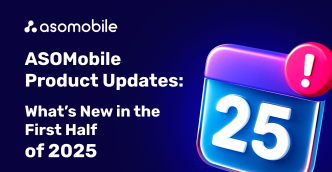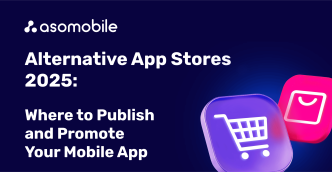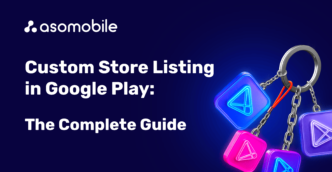ASO for Indie developers. Part 1.
ASO for independent developers, or as Indie developers are commonly called, is an entirely optional process. How can analytics and optimization help in developing an excellent mobile game? And the correct answer will be - most likely, not at all. But suppose you look at it more comprehensively. In that case, games are not created in a vacuum - if the influence of trends and tendencies, the competitive field, and, most importantly, we must arrange a meeting between users and our fantastic game. And this is where mobile analytics tools and ASO optimization come into play.
In short, we can easily create and develop a game without ASO, but optimization is impossible for it to be found and installed.
I think this is why almost every mobile application analytics platform has its own plan: a set of optimization tools that will help an Indie developer optimize the developed game.
Mobile games and users
Let's see where mobile games get users from. According to the analysis of traffic sources, the leading resource is search 48% of users install games from search.
Therefore, search engine optimization is the key to installs. Since we are here thinking about optimization for indie developers, this is not about large advertising budgets; therefore, focusing efforts on organic traffic is the right strategy.
Thinking that the target audience for mobile games is all gamers is quite overconfident. There are games where more than half of the players are women, and there are games for children, so targeting gamers in general is difficult and inefficient. Therefore, the first thing we go to is competitors.
- Open sources - advertising creatives. We remember about the open repository from the App Store. In addition to successful and working options, we can find unsuccessful examples. Also, suppose we started research before developing the game (which is the most correct strategy). In that case, we can look at competing games' interfaces, colors, and schematic solutions and conclude in our favor.
- Game and app stores. Studying stores at the moment of inspiration and analysis is a must-have for any interested party. And if we are talking about independent developers, they are generally marketers and targetologists, very versatile specialists.
- Social media. Advertising and promoting games on social networks has recently become commonplace; people no longer talk about it. But using them to understand your target audience better and users is a must.
The study and analysis of the behavior of mobile game users is a huge section filled with analytical data and indicators. Still, we will discuss something else when considering the target audience regarding game optimization. Instead, it’s about how they search for a game, what words to use to describe the search query, and what the store will show them.
Therefore, we will direct the primary efforts in working with competitors precisely on this - how they optimized their games, how they find users, and what things we discovered we will apply in our ASO strategy.
Any mobile app marketing effort should start with positioning our game for discovery. ASO plays a strategic role for Indie developers; we set ourselves the goal of maximum organic traffic with limited budgets. Indeed, unlike large companies, the developer relies only on his own strength, and in this case, he must master the principles of optimizing apps and games.
If we talk about optimization, it’s worth clarifying the essential points.
- Identification of competitors. We can do this ourselves - fortunately, app stores and industry reviews are available. Or take the path of least resistance and work through analytics.
- Working with keywords. We need to find and evaluate how users will search for our game. In other words, we must think like users and act like developers. We are the ones who know the functionality and main features, and analytics will help us understand the users.
- Generation of metadata - we will use keywords on our game page on the store. Thus, we will draw an analogy for stores - what our game is about and for what search queries it should appear in the search results.
- Visual elements. Once the user has been able to find us, they should now want to install us. Our icons, screenshots, and video should convince them this is their desired game.
- Performance analysis - in addition to the release and implementation of metadata, we must understand what we ended up with. For what keywords and where do we appear on the app store, what is happening with our competitors, and if we have missed any exciting segment of users? Thanks to analytics, we can easily repeat the cycle of actions from the beginning, but not from scratch, focusing on the market.
ASOMobile and ASO Indie
In fact, it sounds much scarier than doing it in practice. A whole pool of various tools and analytical platforms is on our side to make the optimization process simple, understandable, and fast. They also forgot to add - budgetary, which is very important within indie development.
There is an idea for a game - PVP, post-apocalyptic world, zombies, shooter. This idea already consists of keywords that describe the style, type of activity, and direction in which we should move next. We type “zombie war” into the App Store search bar and select the game we like as an example and the basis for ASO optimization. Thus, clarity and a practical approach will prevail in our case of optimizing an indie game. Mobile analytics offered by ASOMobile is a unique package solution for Indie developers - a plan of the same name. We will go through all the tools and see what we can get.
We chose Zero City as the basis for the optimization example.
The next step is to decide on the geo, i.e., the country where we will optimize our game. Let's be apparent right away: here, we are talking about localizing the page of our game, not about translating the gameplay itself. You can read about the role of localization here.
Localization - USA.
Platform - iOS (analytics makes it possible to carry out localization for two stores).
Link to the game - Zero City
So, we have everything to go through all the steps of text optimization of our future game. Add a link to the game and country, and let's go!
Collecting keywords

Please note that based on this link, we are already starting to collect keywords, thanks to analytics tips. Keyword Monitor is the first tool where analytics automatically takes us after adding a game.

There are already semantics here, i.e., search queries (26 keywords and phrases). We will see our search queries here, which can be collected thanks to other analytics tools.
We will not dwell in detail on Keyword Monitor for now since this is only the initial stage. After working with the keywords, we’ll return to it; know that everything you can find and add will be stored here.
Please note that among the wide variety of tools, they are distributed in sections, and for now, when generating data for optimization, we will be in the ASO section.
Almost every tool that we will turn to has a Competitors tab - this is understandable; it is the competitive field that forms the search results in stores, and it would be nice for us to find out who they are and what keywords they are indexed by because we want those too. That's why we will move on to Keyword Check.
Keyword Check
A tool that will show us an analysis of any search query - traffic volume, competitors, store tips. We can use it to identify and add our leading competitors to our analytics because ASO optimization will occur based on the competitive field. To do this, we enter the most general key from the name of our game, which underlies optimization, as a search query and get the result - not only query analytics but also a list of competitors.

We add them to analytics. This way, we can enter all the popular queries that interest us and create a picture of our competitors.
As for popular search queries, Trending Searches will show us trends and tendencies, free and paid categories, and the longest-lived and popular search queries.
We can also look at data for any month and understand if there is any seasonality in popular queries - this will make it possible to predict and consider market influences on the optimization strategy.
Now, back to our keywords and the following tool that is difficult to underestimate - App keywords. It is the one that shows us the indexing by keywords of any application, i.e., we see for what search queries our competitors are shown, in what place, as well as analytics of these keywords (how many users are looking for such a key, how popular it is, how many apps and games are already indexed by it, etc.).
App Keywords
A tool in every ASO specialist's kit, let's see why and how we will use App Keywords for our optimization.

This is what the list of keywords our game is indexed looks like - the basis for optimization, +2000 queries. Don’t be surprised if you see queries here that are entirely unrelated to the game; indexing is not only based on keywords indicated in the metadata. And for many factors, this is why it is so essential to engage in text optimization. After all, without it, our game can show for completely unrelated requests, but no one will find it for those we need. But first things first.
App Keywords allows us to add keywords of interest to the semantic core. What keywords are we interested in?
- Relevant, that is, those that describe the functionality of our game, its style, target audience, etc. Checking for relevance can be done in the following way - you need to look at the search results for this query, and if our direct competitors are there, feel free to take it into our semantic core. Then we will have the opportunity to clean it and analyze it.

- Keywords that users are searching for. So, those search queries that have traffic. Please note that every keyword in App Keywords has this metric. Let’s immediately point out that search queries such as game, strategy game are super popular, which means high competition. But this does not mean we must avoid them - we add them to our work.
- Those by which competitors are indexed. To do this, go to the Competitors tab and add all the keywords that interest us.
Having added all the keywords we think are suitable, we don’t stop and use the following tool - Keyword Suggest.
Keyword Suggest
It’s immediately apparent from the name that we will work with tips. Remember the search mechanism on the app store: we enter words, and the store immediately offers us everything that we have previously searched for on this issue, just like Google. But since they were looking for it, these are relevant and suitable keywords. Analytics makes it possible to work with all store tips in one click. Let's see what we can gather from the zombie keyword suggestions:

By going through queries, we will significantly supplement our semantics with hints. These, by the way, are arranged in alphabetical order and even include numbers. What else are good tips? Users will not manually enter long search queries but happily click them in the tips. So, we confidently add everything that fits into our keyword pool.
Keyword Select
We continue to search and expand our semantic core. The Keyword Select tool will show us queries similar to those we entered for analysis. These may be the most popular queries among users, and we will find similar ones, allowing us to cover more search queries in our optimization. If we have any doubts, we always check the search results for the presence of competitors.

Please note that we will not brush off shooter requests, not with zombies, but with aliens. Users looking for a shooter will have a choice - but who will be in the lead role may not be so important. Plus, this way, we understand the popularity of the shooter query in our semantic core. This will be useful to us in the future.
Keyword Finder
A tool in which you don’t need to analyze anything - it works based on the queries that are already in analytics. That's why we won't use it first.

We add everything suitable to the semantic core, not forgetting to check dubious keywords for relevance using search results.
Spy Explorer
It's time to go and look at the competition. Spy Explorer was created so that, in a convenient form, we can compare either our game with a competitor or two competitors.

This can be used as a source of semantics because we can analyze keywords, expand our semantic core, and compare positions and the number of indexed queries.
Keyword Monitor
We collected 165 key queries with all tools in Keyword Monitor

Now, we have several more options to expand this list - analyzing suggestions for each word.

And now, we can move on to analysis.
Semantic core analysis
After we have used all the available tools for collecting keywords, it’s time to analyze them, look for other possible clues, and arrange the core conveniently for further work.
- We sort the keywords by traffic indicator and exclude indicator 0 or -. For speed and convenience, you can use the traffic filter.
- We check words for relevance using search results or logic. For example, the Warcraft or For Kids keys are clearly out of context; let’s use a word filter and delete all related search queries.
- We sort the core by traffic. There are convenient color filters for this, which allows us to divide our semantics into three zones conditionally - we mark keys with a high traffic indicator in green, the average value ones in orange, and the rest of the semantics in yellow. Colors can be chosen randomly; the main thing is that it is clear to us.

As a result, our semantic core acquired its final form, and 92 queries remained; all of them fit the functionality of our future game and are popular among users.

The difference in the generation of the semantic core for the App Store and Google Play
In this practical case, we looked at how to collect semantics for iOS games and apps. For Android, we will do precisely the same. There is only one metric that will be different - Apple Search Ads. It exists only for iOS games and applications; it serves as an additional guide and source of semantics when there are very few search queries in a niche, and we can find ideas in advertising from competitors. So, compiling a semantic core for Google Play is just as easy as for the App Store; there is only one thing: you must compile it separately without using one semantic core for two stores. Many studies talk about the differences in user behavior, how they behave, and what they look for in app stores. According to our practical experience, the semantic core for the App Store is always different from Google Play.
This concludes the first article in the ASO series for Indie developers. But as a result of the publications, we will have detailed instructions on optimizing a mobile game on our own and with the help of ASOMobile analytics. In the following publication, we will look at the formation of metadata for our game.
 Українська
Українська  Русский
Русский  Español
Español 






